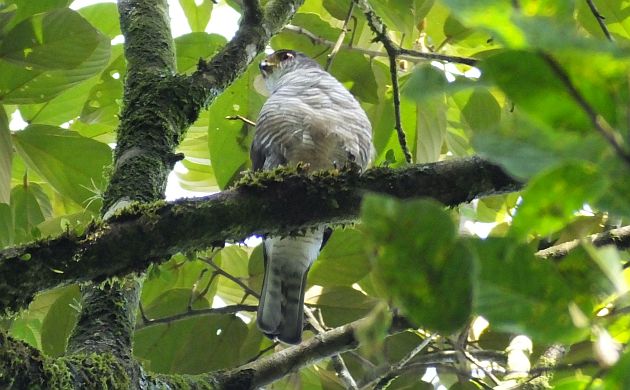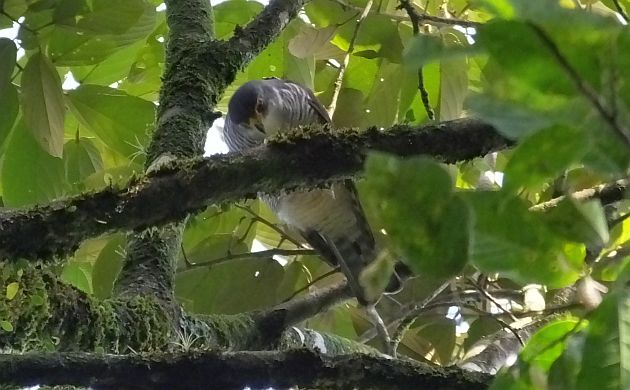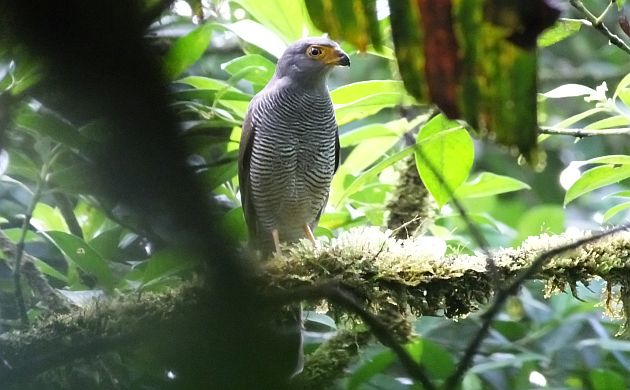
The irony of birding in tropical forest is that although there are literally hundreds of bird species, a pretty high percentage of them are naturally rare. That is, they occur at very low densities in high quality habitat. It’s just the way it is, and we probably can’t have it any other way because individual birds don’t just compete with others of the same species, they also compete with a lot of other birds and who knows what else for food, shelter, and nest sites. It makes for a smorgasbord of birds with never-ending players instead of the same, predictable kids on the avian block.
It also means that you can bird the same rich site for days on end and just keep seeing new species and new behaviors. However, there are some species that seem to defy all odds at being seen or heard even though you know that they must be around because the habitat calls for it, and past eBird records prove their presence (at least back when the species was seen). In Costa Rica, and most parts of its range, one of those choice, naturally rare birds is the Tiny Hawk. Bird in and at the edge of rainforest from eastern Honduras to the Amazon and you are probably within range of one of these miniature raptors. It might be a couple trees away or it might be lurking in the canopy two ridges over but it doesn’t matter because you will never see the darn thing anyways!
The hawk is so small (like American Robin small), it just hides in plain sight. All it has to do is sit up there in some dense canopy and its gone. Since it doesn’t soar, we can forget about that possibility, and it hardly ever calls either. So, what do you need to do see one of these cool little raptors? Basically, you need to get lucky like my friend Susan and I did during a recent count at Quebrada Gonzalez.

Tiny Hawk-lucky day!
Not only were we lucky to find that bird where we could see it, I was also lucky that Susan was keeping an eye on the canopy while I watched the trail for snakes while counting my steps somewhere between points five and six. I was on a mission and my ears were always open, but ever since I nearly stepped on a massive Fer-de-lance in 2009 at around the same area where we saw the Tiny Hawk, I won’t walk on a rainforest trail until I have inspected the ground at least ten feet ahead. It means that I have to forego any jogs through the rainforest but I’ll take the slow, more birdy, and safe road over risking an outside chance at getting injected with an anti-protein, coagulating venomous blend.
But, back to the literally Tiny Hawk. Susan noticed it because her sharp eyes caught a tiny (naturally) bit of movement up in the subcanopy. That movement turned out to be the hawk plucking feathers from some small green bird. We couldn’t tell what the other bird was or if it was even a hummingbird (one of the main prey items of Tiny Hawks), but it made it possible to watch this rare species for several minutes.

This was a major treat!
Eventually, when it was apparently satiated, the hawk flit to another branch (yep, kind of like any other small bird), and before we knew it, disappeared. It was good to note this because we could easily see how a Tiny Hawk can just fly to the other side of a tree and never be seen again because it is blocked from view by a small branch or petty leaf. As further testament to the difficulties involved in coming across this species, I have birded at Quebrada Gonzalez in Braulio Carrillo National Park for several years, and had never seen a Tiny Hawk there previously. However, knowing how that bird is, I always figured it was there and knew it was a matter of time before I saw one. I just didn’t expect that matter of time to span more than a decade and a half!
Actually, though, I’m not surprised that I never saw it there before this recent trip because despite there being excellent habitat for Tiny Hawk, the site lacks a couple key conditions that increase one’s chances of laying eyes on this little raptor. On the handful of other occasions when I have seen this species well, it has either been from a canopy tower, or seen at the top of a bare tree near the edge of the forest. I have also seen a few zip in and out of view but that doesn’t really count. At Quebrada, viewing into the 100 plus foot canopy is mostly from way down below. Add a healthy dose of bromeliads and other stuff growing all over the trees and getting good views of almost any canopy species is nearly impossible. Since the forest is mature and quite dense, there really aren’t any semi-open areas where one might like to perch at the top of a tree either.
Not to mention, if you do focus the bins on a Tiny Hawk, you have to make sure that you aren’t seeing another, shy rainforest raptor with similar plumage, the Barred Forest-Falcon.

This bird seems to be much more common than the Tiny Hawk but is also a pain to see for some of the same reasons.
It just goes to show that you have to always carefully listen and watch for anything in the same mature rainforest site because those naturally rare species do eventually appear.













I’ve always admired the Tiny Hawk in the book and hoped to see one. Now I know why I haven’t. Thanks for all the good info and congrats!